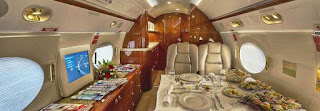The Hawker 750 has been around for decades and they are very hard to find.
https://centraljetcharter.com/hawker-750.html
"Hawker 750, Information!"
The new engines in the Hawker 750 at the time, represented quantum leaps in efficiency.
It enabled a new generation of six- to eight-passenger corporate jets that can still pass Stage III noise requirements.
The 750 is only marginally faster than the XLS+ on most missions and considerably slower than a Learjet 60.
However, most Hawker flights are considerably shorter, and on a trip from, say, Chicago to Atlanta, the speed disadvantage won’t cost you more than about 10 minutes.
With full fuel, payload is an impressive 2,250 pounds (1,021 kg). However, also like its predecessors, the 750 remains challenged when it comes to baggage capacity, to a point.
Unlike previous 700, 800 and 900 series siblings, the 750 has a separate, heated, externally accessed baggage compartment that holds up to 500 pounds (227 kg).
"Haweker 750 Inside"
hawker 750 inside
The Hawker 750’s biggest advantage is in its cabin, a fuselage-stretch modification first enjoyed by the 800 series.
The cabin measures 21.3 feet-long, 5.7 feet-high and 6 feet wide, almost comparable to the class above.
It can swallow items as bulky as golf clubs. Combined with the traditional 47 cu ft (1.3 cu m) of stowage space in the cabin, this gives the 750 a total of 79 cu ft (2.2 cu m) of baggage space.
It comes as the expense of range. The 220-gallon fuselage fuel tank is removed to make the space, reducing the 750’s range with four passengers to 2,195 nm (4,065 km).
Compared with the 900XP’s 2,600-nm (4,815-km) range. Range with eight passengers still exceeds 2,000 nm (3,700 km).
You can increase range by 100 nautical miles and slash time to climb 5 percent by adding aftermarket winglets from Hawker Beechcraft.
The aircraft’s optional $295,000 winglets also produce modest handling improvements at lower airspeeds.
Even without them, though, the 750 can fly farther than any comparable airplane near its price point.
Range aside, taking out the center fuel tank makes the airplane lighter and, depending on how heavily it’s loaded, the 750 can now get into airports with shorter runways–places Hawkers have never been before.
Fully loaded at 26,950 pounds (8,500 of that is fuel), the 750 can easily negotiate 5,000-foot runways.
It can also land on gravel and grass strips, something best not tried in a 60-series Learjet.
The Hawker 750/800XP is a spacious midsize aircraft with impressive range and a sleek, spacious interior featuring stand-up headroom and full refreshment center.
"Hawker 750, Flight Charter Services!"
"Hawker 750, Information!"
The new engines in the Hawker 750 at the time, represented quantum leaps in efficiency.
It enabled a new generation of six- to eight-passenger corporate jets that can still pass Stage III noise requirements.
The 750 is only marginally faster than the XLS+ on most missions and considerably slower than a Learjet 60.
However, most Hawker flights are considerably shorter, and on a trip from, say, Chicago to Atlanta, the speed disadvantage won’t cost you more than about 10 minutes.
With full fuel, payload is an impressive 2,250 pounds (1,021 kg). However, also like its predecessors, the 750 remains challenged when it comes to baggage capacity, to a point.
Unlike previous 700, 800 and 900 series siblings, the 750 has a separate, heated, externally accessed baggage compartment that holds up to 500 pounds (227 kg).
"Haweker 750 Inside"
hawker 750 inside
The Hawker 750’s biggest advantage is in its cabin, a fuselage-stretch modification first enjoyed by the 800 series.
The cabin measures 21.3 feet-long, 5.7 feet-high and 6 feet wide, almost comparable to the class above.
It can swallow items as bulky as golf clubs. Combined with the traditional 47 cu ft (1.3 cu m) of stowage space in the cabin, this gives the 750 a total of 79 cu ft (2.2 cu m) of baggage space.
It comes as the expense of range. The 220-gallon fuselage fuel tank is removed to make the space, reducing the 750’s range with four passengers to 2,195 nm (4,065 km).
Compared with the 900XP’s 2,600-nm (4,815-km) range. Range with eight passengers still exceeds 2,000 nm (3,700 km).
You can increase range by 100 nautical miles and slash time to climb 5 percent by adding aftermarket winglets from Hawker Beechcraft.
The aircraft’s optional $295,000 winglets also produce modest handling improvements at lower airspeeds.
Even without them, though, the 750 can fly farther than any comparable airplane near its price point.
Range aside, taking out the center fuel tank makes the airplane lighter and, depending on how heavily it’s loaded, the 750 can now get into airports with shorter runways–places Hawkers have never been before.
Fully loaded at 26,950 pounds (8,500 of that is fuel), the 750 can easily negotiate 5,000-foot runways.
It can also land on gravel and grass strips, something best not tried in a 60-series Learjet.
The Hawker 750/800XP is a spacious midsize aircraft with impressive range and a sleek, spacious interior featuring stand-up headroom and full refreshment center.
"Hawker 750, Flight Charter Services!"





Midsize Jet Charter Services.
ReplyDeleteNice Jet.
Delete